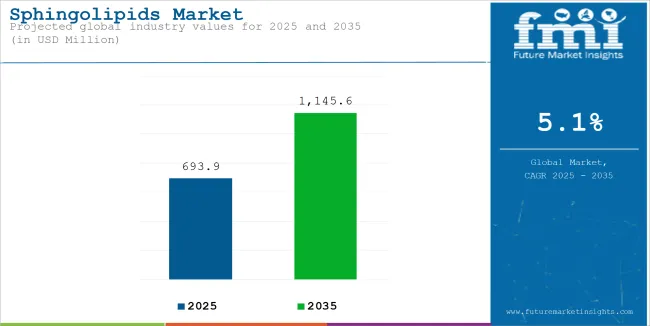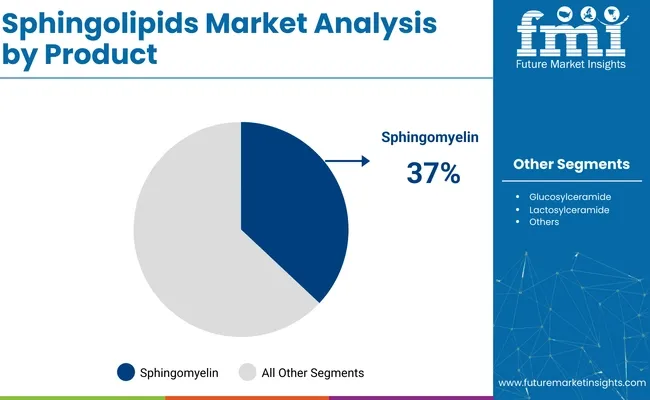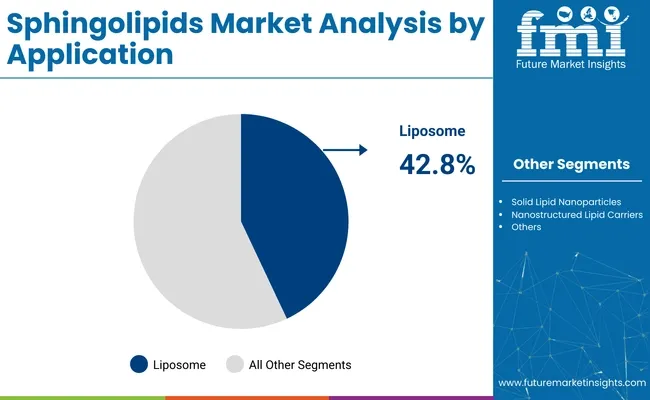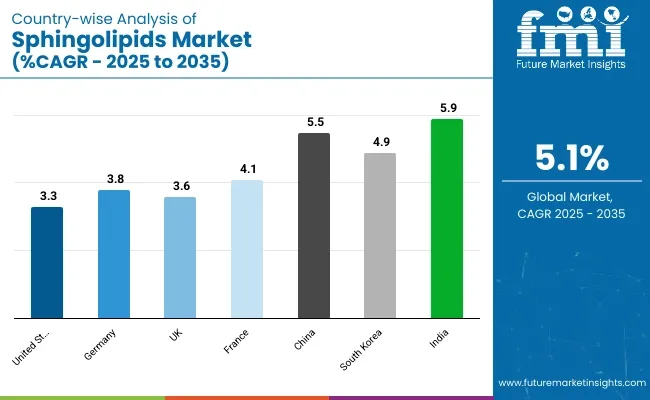The global sphingolipids market is projected to be valued at USD 693.9 million in 2025 and is expected to reach USD 1,145.6 million by 2035, registering a CAGR of 5.1% during the forecast period. This growth is driven by expanding applications in pharmaceuticals, nutraceuticals, and cosmetics.
In the pharmaceutical sector, sphingolipids are gaining attention for their roles in cell signalling and apoptosis, making them valuable in developing treatments for cancer, neurodegenerative diseases, and metabolic disorders. Advancements in lipidomics and personalized medicine are further enhancing their therapeutic potential.
In cosmetics, the demand for bio-based and sustainable products has led to increased use of sphingolipids, particularly ceramides, for skin hydration and anti-aging benefits. The nutraceutical industry is also incorporating sphingolipids for their functional health benefits, including support for cellular health and metabolic balance. Overall, the market's growth is underpinned by technological advancements, strategic collaborations, and increasing R&D investments across these industries.
Prominent players in the sphingolipids market include Evonik Industries AG, CLR Berlin, and CD Bioparticles. These companies are actively expanding their product portfolios and investing in research to enhance sphingolipid applications. Croda International introduced SphingoCare™, a range of sphingolipids and ceramide-based skin conditioning agents designed for cosmetic applications.

Global Sphingolipids Industry Assessment
| Attributes | Key Insights |
|---|---|
| Estimated Size, 2025 | USD 693.9 million |
| Projected Size, 2035 | USD 1,145.6 million |
| CAGR (2025 to 2035) | 5.1% |
These ingredients are primarily biotechnology and plant-derived, available in high-purity levels, pre-dispersions, or biomimetic blends. SphingoCare™ products offer benefits such as skin hydration, scalp well-being, soothing effects, environmental protection, lip care, microbiome balance, and hair cuticle smoothing.
Technological advancements, such as the development of sphingolipid-based nanocarriers for targeted drug delivery, are also influencing market growth. These innovations enhance the bioavailability and efficacy of therapeutic agents, opening new avenues in pharmaceutical applications. As research progresses, such technologies are anticipated to play a pivotal role in expanding the utility of sphingolipids across various sectors.
The sphingolipids market in North America and Europe is being significantly driven by advancements in pharmaceutical and cosmetic industries. In North America, particularly the USA, the adoption of sphingolipids in drug formulations for cancer and neurodegenerative diseases has been accelerated by a strong focus on personalized medicine and clinical research.
Concurrently, the demand for natural cosmetic ingredients, such as ceramides, has been elevated by consumer preference for bio-based skincare products. In Europe, market growth is being supported by stringent regulatory frameworks and high product quality standards. Increased utilization in pharmaceuticals and cosmetics has been further reinforced through EU-funded research on metabolic and neurological disorders. Additionally, the use of sphingolipids in functional foods and supplements is being expanded in alignment with holistic wellness trends across both regions.
The global sphingolipids market's compound annual growth rate (CAGR) for the first half of 2024 and 2025 is compared in the table below. This analysis provides important insights into the performance of the industry by highlighting significant shifts and trends in revenue generation.
The first half (H1) is the period from January to June, and the second half (H2) is July to December. In the first half (H1) of the decade from 2024 to 2034, the business is predicted to surge at a CAGR of 5.8%, followed by a slightly lower growth rate of 5.5% in the second half (H2) of the same decade.
| Particular | Value CAGR |
|---|---|
| H1 (2024 to 2034) | 5.8% |
| H2 (2024 to 2034) | 5.5% |
| H1 (2025 to 2035) | 5.1% |
| H2 (2025 to 2035) | 4.6% |
Moving into the subsequent period, from H1 2025 to H2 2035, the CAGR is projected to decrease slightly to 5.1% in the first half and remain relatively moderate at 4.6% in the second half. In the first half (H1) the industry witnessed a decrease of 70 BPS while in the second half (H2), the industry witnessed a decrease of 90 BPS.
The sphingomyelin segment has been estimated to account for 37.0% of the total market revenue in 2025, making it the leading product category within the sphingolipids market. This dominance is being attributed to sphingomyelin's essential role in maintaining cellular membrane integrity and signal transduction pathways, particularly in neural tissues.
It has been widely recognized for its involvement in myelin sheath formation, which is critical for proper nerve function. As research continues to focus on neurodegenerative disorders such as Alzheimer’s and Parkinson’s diseases, sphingomyelin’s therapeutic potential is being explored extensively.

Moreover, increased demand for functional lipids in infant nutrition, especially in infant formula compositions, has further accelerated its adoption. Its bio-functional properties are being leveraged to replicate the benefits of human breast milk fat composition.
Rising healthcare awareness and growing investments in clinical research have also strengthened the segment. Additionally, its utilization in cosmeceuticals for improving skin barrier function has expanded its industrial footprint. These combined factors have reinforced sphingomyelin's market leadership and long-term growth trajectory.
The Liposome Drug Delivery Systems (LDDS) segment has emerged as the leading application segment, holding 42.8% of the total market revenue share in 2025. This leadership is being driven by the surging demand for targeted and controlled-release drug delivery platforms, particularly in oncology. Liposomes, due to their biocompatible and biodegradable nature, have been increasingly used to encapsulate chemotherapeutic agents, thereby improving efficacy while minimizing systemic toxicity.

This technology has been extensively validated in both clinical and commercial pharmaceutical landscapes, supported by a growing body of evidence on its pharmacokinetic and pharmacodynamic benefits. Regulatory approvals for liposomal formulations in cancer therapies and vaccines have further contributed to its adoption. In addition, advances in nanotechnology and lipidomics have enabled the design of liposomes with improved stability, precision, and drug loading capacity.
The ability of LDDS to cross biological barriers and deliver active agents at target sites with minimal immunogenic response has been recognized as a significant advancement in modern drug delivery science. The market has also been influenced by ongoing investments in biopharmaceutical R&D, which are accelerating pipeline developments and further cementing the segment’s dominance in the sphingolipids application landscape.
Rising Demand in the Cosmetic and Nutraceutical Industries is driving growth
There has been a significant use of sphingolipids in the Cosmetic and nutraceutical industry. Cosmetic usage of sphingolipids have risen with high adoption in ceramides for the restoration and maintenance of skin barrier. This in turn enhances the hydration and anti-aging properties and thus creating demand for these products.
The manufacturers of Anti-aging and moisturizing products are considering sphingolipids to an large extent in each of the skin care their portfoliosproducts. Bio-based and sustainable products have led to the inclusion of naturally derived sphingolipids in premium skincare solutions.
The nutraceutical industry is taking advantage of the benefits of sphingolipids for developing functional foods and dietary supplements. Emerging research is underpinning their potential role in brain health supplements which enhancing cognitive functions and metabolic wellness. For instance, sphingomyelin contributes to the formation of the myelin sheath, which is very important for neurological health. Thus, there has been interest in adding sphingolipids to functional foods focused on cognitive enhancement and elderly populations.
With consumer trends shifting toward wellness, the scientific innovations in bioactive lipid formulations lead to a rich demand landscape. The dual attractiveness in both the cosmetic and nutraceutical streams establishes sphingolipids as versatile, essential ingredients to sustain growth within the market
Advancements in Lipidomics Research and Precision Medicine is driving the industry growth
The sphingolipid market has continued to be characterized by a host of positive contributions provided by rapidly evolving researches related to lipidomics and increased precision medicines. Lipidomics is considered to be the sub process of metabolomics. The different structural types and functionality associated with sphingolipids or any lipids get successfully demarcated due to these practices.
These highly sophisticated methods like mass spectrometry, HPLC, and nuclear magnetic resonance techniques revolutionized this subject field. This has provided deep insight into their role in critical cellular processes such as membrane dynamics, signal transduction, and apoptosis.
In parallel, precision medicine has come out further to boost the interest in sphingolipids during the course of drug development and management of diseases. Their bioactive properties make them ideal candidates for targeted therapies against chronic diseases such as cancer, diabetes, and cardiovascular and neurodegenerative diseases.
For example, ceramides are under evaluation as biomarkers of metabolic syndrome and targets of anti-cancer therapies, whereas gangliosides have neuroprotective applications. However, this demand is further bolstered by the high possibility of improving therapeutic efficacy, as well as decreasing adverse effects of sphingolipid-based solutions for personalized health.
These developments underline their crucial role in the advancement of modern healthcare and keep this market very lively and fast-changing.
Expanding Applications in Neurodegenerative Disease Therapy is Creating Opportunities in the market
Among the various applications that sphingolipids to offer, few of the more promising opportunities would pertain to neurological disorders treatments. Neurological diseases such as Alzheimer's, Parkinson's among others pose great health hazards for mankind, mainly during the aging process and as this population increases.
Recent studies have reported on changes in sphingolipid metabolism contributing to the pathophysiology of neurodegenerative diseases. For example, accumulation of ceramide has been implicated in neuronal apoptosis of Alzheimer's disease (AD), and gangliosides are promising in their prospects for nerve regeneration and reduction of inflammation.
Pharmaceutical companies are investing in research and development, so as to tap into therapeutics forms of sphingolipids that can be used in neurodegenerative diseases. Partnerships between academic researchers and industry have accelerated innovative formulation and delivery systems that increase bioavailability and efficacy.
On top of these, recent advances in lipidomics and precision medicine allow for more personalized neurodegenerative disease management and open newer avenues for sphingolipid-based treatments.
High Production Costs and Complex Extraction Processes Restricting Market Growth
The high cost of production and challenges in the modes of extraction continue to hamper the market, limiting promising applications for sphingolipids. The sphingolipids are obtained from natural tissues of animals or by chemical synthesis, involving resource-intensive processes. Due to structural diversity, precise methods of isolation and purification in advanced equipment and expertise are required from sphingolipids. This does not only increase the cost of production but also complicates the scaling up, especially during mass production.
Besides, the yield of sphingolipids from natural sources is normally low, requiring large amounts of raw material, which also increases the production cost. Synthetic production pathways, though promising a higher yield, involve sophisticated and time-consuming chemical processes that make them costly as well. Together, these contribute to high market prices for sphingolipid-based products, limiting their use in price-sensitive markets.
Other issues also include the ecological footprint of extraction, especially from animal tissues, raising questions of sustainability. Increasing interest by consumers and industry in more ecologically friendly and ethical products further puts pressure on the manufacturers to invest in greener and cheaper routes of production. Such challenges have to be responded to with innovatory biosynthetic pathways and sourcing methods that bring down the production cost and widen the circle of accessibility.
Tier 1 companies are the industry leaders with 64.2% of the global industry. These companies stand out for having a large product portfolio and a high production capacity. These industry leaders also stand out for having a wide geographic reach, a strong customer base, and substantial experience in manufacturing and having enough financial resources, which enables them to enhance their research and development efforts and expand into new industries.
The companies within tier 1 have a good reputation and high brand value. Prominent companies within tier 1 include Merck KGaA, CordenPharma International and Lipoid GmbH
Tier 2 companies are relatively smaller as compared with tier 1 players. The tier 2 companies hold a market share of 19.1% worldwide. These firms may not have cutting-edge technology or a broad global reach, but they do ensure regulatory compliance and have good technology. The players are more competitive when it comes to pricing and target niche markets. Key Companies under this category include Croda International Plc, Biosynth, LARODAN AB and Santa Cruz Biotechnology, Inc.
Compared to Tiers 1 and 2, Tier 3 companies offer Sphingolipids, but with smaller revenue spouts and less influence. These companies mostly operate in one or two countries and have limited customer base. The companies such as Intas Pharmaceuticals Ltd, Macleods Pharmaceuticals Ltd., and others falls under tier 3 category. They specialize in specific products and cater to niche markets, adding diversity to the industry.
The market analysis for sphingolipids in various nations is covered in the section below. An analysis of important nations in North America, Latin America, Western Europe, Eastern Europe, East Asia, South Asia & Pacific, and Middle East & Africa of the world has been mentioned below. It is projected that the United States will maintain its leading position in North America through 2035, holding a value share of 89.7%. By 2035, China is expected to experience a CAGR of 5.5% in the Asia-Pacific region.
| Countries | Value CAGR (2025 to 2035) |
|---|---|
| United States | 3.3% |
| Germany | 3.8% |
| UK | 3.6% |
| France | 4.1% |
| China | 5.5% |
| South Korea | 4.9% |
| India | 5.9% |

The market for sphingolipids in Germany is poised to exhibit a CAGR of 3.8% between 2025 and 2035. The Germany holds highest market share in European market.
In Germany, the growing demand for sphingolipids is mostly driven by the adoption of biotechnology across pharmaceutical industries known for quality research development and innovation. Today Germany has become a hotspot in lipidomics research: much investment is being made in the studies of prized bioactive lipids like sphingolipids for their applications in curing chronic diseases like cancer, neurodegenerative diseases, and cardiovascular disorders.
The strong research infrastructure, supported by academic institutions and well-established biopharmaceutical manufacturers in Germany provides an enormous growth opportunity for the market of sphingolipids. Besides it, the growing precision medicine focused in Germany supports the demand for sphingolipid-based formulation and therapeutic development.
Germany has been leading in offering personalized treatments, especially in oncology, and this has further developed the need for sphingolipid-based solutions. Moreover, with the increased dedication by Germany for sustainable development and plant-derived goods, its needs for sphingolipids are being amplified by nutraceuticals and cosmetics.
United States is anticipated to show a CAGR of 3.3% between 2025 and 2035.
Sphingolipid-based solutions are also being increasingly demanded as a result of the focus by the National Institutes of Health and other federal agencies on precision medicine. A second aspect is the increased attention paid to chronic disease management and the United States elderly population, driving demand for sphingolipid-based targeted therapeutics and diagnostics.
The United States also has a very developed nutraceutical and cosmetic industry, with increasing interest in anti-aging and skin-care products, which continues to increase demand for sphingolipids in these applications.
The United States is the market leader in the sphingolipids market due to its high-quality research and development skills in pharmaceuticals and biotechnology. Among these countries, the United States hosts several of the leading pharmaceutical companies, which are very much active in sphingolipids in search of therapeutic uses in the treatment of cancer.
India is anticipated to show a CAGR of 5.9% between 2025 and 2035.
The major driving force for the sphingolipids market in India is the growing healthcare infrastructure and increasing demand for advanced therapeutic solutions. There is a significant increase in the prevalence of chronic diseases, including cancer among other disorders that create an urgent need for targeted therapies and precision medicine, wherein sphingolipids are playing an important role.
The Indian pharmaceutical sector, one of the largest in the world, is rapidly adopting sphingolipids in drug formulations for better efficacy in treating these diseases.
India's increasing biotech ecosystem and its position as a global hub for clinical trials have increased research and development on bioactive lipids-the driving force behind innovation in the sphingolipids market. Additionally, awareness of health care treatment and availability are making a pathway for sphingolipid-based nutraceuticals and cosmetic products that have further increased the market than pharmaceutical.
In India, because of the population and efforts made by the government to improve access to healthcare to remote regions, there is higher demand for inexpensive and effective treatments, pushing sphingolipid applications deeper into the mainstream.
In terms of this market, the companies involved are resorting to multiple strategies to retain a competitive position. These involve product innovation to create advanced therapies like combination treatments, biologics, and new drug delivery systems to ensure greater efficacy and compliance from the patient.
Strategic partnerships and collaborations with research institutions and healthcare providers are being utilized to broaden their product portfolio. Geographical expansion into the emerging markets, particularly China and India, has been another strategic priority for these companies, where growth in the healthcare infrastructure and awareness is strong.
Recent Industry Developments in Sphingolipids Industry Outlook
In terms of product, the industry is divided into Ceramide, Sphingomyelin, Glucosylceramide (GlcCer), Lactosylceramide (LacCer), Ganglioside GM3 among Other.
In terms of source, the industry is segregated into synthetic, semi-synthetic and natural
In terms of application, the industry is divided into Conventional Lipid-based Drug Delivery Systems (LBDDS), Self-Emulsifying Drug Delivery Systems (SEDDS), and Self-Micro emulsifying Drug Delivery Systems (SMEDDS), Liposomes, Solid Lipid Nanoparticles, Nanostructured Lipid Carriers and Others.
In form segment, the industry is segregated into Liquid, Semi-solid and Solid
In terms of end user, the industry is divided into pharmaceutical companies, biopharmaceutical companies, academics and research institutes among others.
Key countries of North America, Latin America, East Asia, South Asia & Pacific, Western Europe, Eastern Europe and Middle East and Africa (MEA) have been covered in the report.
The global sphingolipids industry is projected to witness CAGR of 5.1% between 2025 and 2035.
The global sphingolipids industry stood at USD 664.2 million in 2024.
The global sphingolipids industry is anticipated to reach USD 1,145.6 million by 2035 end.
China is expected to show a CAGR of 5.5% in the assessment period.
The key players operating in the global sphingolipids industry are Merck KGaA, CordenPharma International, Lipoid GmbH, Croda International Plc, Biosynth, LARODAN AB, Santa Cruz Biotechnology, Inc. and Creative Enzymes among others






Full Research Suite comprises of:
Market outlook & trends analysis
Interviews & case studies
Strategic recommendations
Vendor profiles & capabilities analysis
5-year forecasts
8 regions and 60+ country-level data splits
Market segment data splits
12 months of continuous data updates
DELIVERED AS:
PDF EXCEL ONLINE

Thank you!
You will receive an email from our Business Development Manager. Please be sure to check your SPAM/JUNK folder too.
Chat With
MaRIA